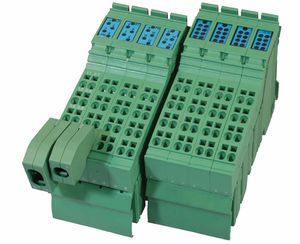LOCON 100 (English)
Inhaltsverzeichnis
Configuration
By factory setting all LOCON 100 cam controls are configured as follows:
- outputs: 16
- Encoder type: SSI Singleturn
- real encoder resolution: 4096
- virtual encoder resolution: 4096
- idle time: Bitwise
This configuration set by default may be changed by using TERM 6 or the software WINLOC 32.
Programming
LOCON 100 can be programmed by TERM 6 or TERM 24 or the software WINLOC 32. The PROFIBUS-Version can be programmed also by PROFIBUS. The Modbus-version can by programmed by Modbus.
device versions
LOCON 100
LOCON 100 features a serial RS232-interface and a RS485-(DICNET) interface, the needed setting is made through the corresponding rotary coding switches High und Low , located at the bottom side of the device.
| High | Low | Meaning |
|---|---|---|
| D | DICNET-Address | DICNET-Operation, Bus Termination inactive |
| E | DICNET-Address | DICNET-Operation, Bus Termination active |
| F | F | RS232-Operation |
Only the DICNET-Addresses 0 ... 15 (decimal) are supported (right Rotary coding switch Low = DICNET-Address). Examples:
| High | Low | Meaning |
|---|---|---|
| D | 3 | bus termination inactive, DICNET-Address 3 |
| E | C | bus termination active, DICNET-Address 12 |
Note: The setting via the rotary coding switches is done in hexadecimal.
LOCON 100-PB (PROFIBUS)
LOCON 100-PB (PROFIBUS) is always PROFIBUS-Slave and features a serial RS232-interface and a PROFIBUS-Interface, instead of the RS485-(DICNET) Interface, the needed setting is made through the corresponding rotary coding switches High und Low , located at the bottom side of the device.
| High | Low | Meaning |
|---|---|---|
| 0 | 0 | PROFIBUS-operation, external address assignment |
| 0 | 1 | PROFIBUS-operation, Address 1 |
| … | ||
| 7 | D | PROFIBUS-operation, Address 125 |
| 7 | E | PROFIBUS-operation, external address assignment |
| F | F | RS232-operation |
Note: The setting via the rotary coding switches is done in hexadecimal.
In LOCON 100-PB two modes are selectable through WINLOC32 via the PROFIBUS-Interface.
- S7-Modus (ex-works condition): For an operation at a Simatic S7 and for use of the Data Block Simulator.
- Communication Profile Mode: For the Operation via the Communication Profile for Deutschmann cam controls.
The PROFIBUS-Address (Slave-ID) is set by factory Setting on 126 (decimal). If the rotary coding switch is on position "00" und "7E" then any desired address can be assigned wither through WINLOC32 or the PROFIBUS-Master. Die GSD-Datei (L100.GSD) und ein S7-Beispielprojekt stehen zum Download zur Verfügung. Weitere Informationen zum LOCON 100-PB sind dem Handbuch Nockensteuerungen mit Feldbusanbindung zu entnehmen.
LOCON 100-MB (Modbus)
Das LOCON 100-MB (Modbus) ist immer ein Modbus-RTU-Slave und ist nur in der 2-Draht-Variante erhältlich. Das LOCON 100-MB verfügt über eine RS232 Standard Schnittstelle sowie über eine RS232-(Modbus-RTU) Schnittstelle und eine RS485-(Modbus-RTU) Schnittstelle, die entsprechend über den Drehkodierschalter High auf der Geräterückseite eingestellt werden können.
| High | Low | Bedeutung |
|---|---|---|
| C | x | RS232-Modbus (X = ModbusSlave-ID) |
| D | x | RS485-Modbus ohne Busabschluss (x = Modbus-Slave-ID) |
| E | x | RS485-Modbus mit aktiviertem Busabschluss (x = Modbus-Slave-ID) |
| F | x | RS232-Standard Schnittstelle |
Hinweis: Es werden nur die Modbus-Adressen 1 ... 15 (Dezimal) unterstützt (rechter Drehkodierschalter Low = ID). Die Broadcastadresse 0 wird nicht unterstützt. Die Einstellung über den Drehkodierschalter erfolgt in hexadezimal.
Folgende Modbus-RTU-Kommandos werden von dem Gerät unterstützt:
| Kommando | Bedeutung |
|---|---|
| 03 | (0x03) Read Holding Registers |
| 16 | (0x10) Preset Multiple Regs |
Die Übertragungsbaudrate beträgt 19200 Baud; No Parity. Weitere Informationen zum LOCON 100-MB sind dem Kapitel 8 LOCON 100 mit Modbus aus dem Handbuch für das LOCON 100 zu entnehmen.
LOCON 100-Out I/O32 (Erweiterungsmodul)
Das LOCON 100-Out I/O32 ist ein Erweiterungsmodul und verfügt über 32 I/Os. Damit kann das LOCON 100 bzw. (-PB)) auf 48 I/Os (inkl. der 16 I/Os des LOCON 100 bzw. (-PB)) erweitert werden. Das LOCON 100-Out I/O32 enthält keinen eigenen Prozessor. Dadurch ist die Schaltgenauigkeit (Zykluszeit) abhängig vom LOCON 100 bzw. (-PB)).
Weblinks
- Handbuch für das LOCON 100 (PDF-Datei)
- GSD-Datei für das LOCON 100-PB
- S7-Beispiel-Projekt (ZIP-Datei)
- Handbuch Kommunikationsprofil für Deutschmann Nockensteuerungen (PDF-Datei)
- Handbuch Nockensteuerungen mit Feldbusanbindung (PDF-Datei)
